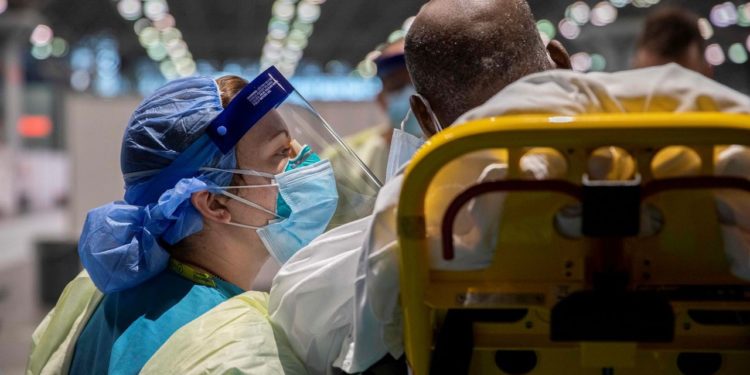Early signs suggest that as summer approaches in the United States, the number of COVID-19 infections there is expected to rise.
The Centers for Disease Control and Prevention (CDC) reported that COVID test positive increased by 0.8{d38a898658503095d09ccca72b3373e8fa824aa4f0215737cc70c89fc7ca3936} from the previous week to 5.4{d38a898658503095d09ccca72b3373e8fa824aa4f0215737cc70c89fc7ca3936} nationwide for the week ending June 8, the latest for which data is available.
COVID test positivity was 12.8{d38a898658503095d09ccca72b3373e8fa824aa4f0215737cc70c89fc7ca3936} in the Western region, which includes Arizona, California, Hawaii, and Nevada. This is greater than in any other area of the United States. The second highest test positivity rate, 5.4{d38a898658503095d09ccca72b3373e8fa824aa4f0215737cc70c89fc7ca3936}, was recorded in the New England region, which includes Connecticut, Maine, Massachusetts, New Hampshire, Rhode Island, and Vermont. This rate was equal to the national average.
Viral activity levels are still low nationwide, but over the past month, they have more than doubled in the western United States, according to CDC wastewater data.
Furthermore, CDC data shows that COVID emergency department visits increased 12.6{d38a898658503095d09ccca72b3373e8fa824aa4f0215737cc70c89fc7ca3936} for the week ending June 8 compared to the week before.
Every year, after the Fourth of July, the United States has historically experienced rises in COVID; however, public health experts predicted that Americans would likely see a “drift upwards” rather than a surge. The ordinary person will be able to handle an increase in instances without any problems, they continued, but those who are at a higher risk of developing serious illnesses should exercise caution and stay vigilant.
“We are at a very, very low rate of COVID, compared to some of our peaks,” Dr. Cameron Wolfe, a Duke University medical professor in the infectious diseases division, said. “To put it proportionally to like where we were in many winters.” “This is completely different, much like it was in early 2022 when omicron first appeared. However, there has been a slight upward tendency, possibly in the past few weeks.
There have been increases in a number of states, mainly along the West Coast. The Department of Public Health for Los Angeles County reported an average of 121 cases on June 13, an increase from the daily average of 106 cases one week earlier.
Experts asserted that high levels of immunity and our growing ability to control the virus will prevent COVID from posing a serious threat to the general public.
Dr. Peter Chin-Hong, an infectious disease expert and professor of medicine at the University of California, San Francisco, said, “Over the last four years, our bodies have learned how to manage the virus, meaning that many people have had successive waves of infection and many people have had initial vaccinations.” “Therefore, the combined immunity creates a powerful force field that can shield us from harm in the heat. While the majority of people will recover, some will still become seriously ill.”
Hospital admissions and fatalities in the US were steady as of Tuesday. The final week of comprehensive data, which ended on May 18, showed 311 COVID-related deaths, the lowest number of deaths in the United States since the pandemic’s start.
According to Chin-Hong, the majority of hospital admissions and fatalities are linked to high-risk populations, which include the elderly (75 years of age and older) and those with impaired immune systems, such as those receiving immune-suppressive drugs or having received organ transplants.
Though he emphasized that an increase in COVID should not be cause for concern, he advises the ordinary person to monitor COVID wastewater data from the CDC to see if it’s heading upward in their area and to keep masks and COVID quick tests ready in case they need them.
“I think there’s a fine balance between ignoring everything and being scared by everything,” Chin-Hong stated. “It is comparable to crossing a roadway. You always check both ways before crossing a busy road, but it doesn’t mean you stop moving toward your next goal. Thus, I believe that’s how we should approach it in the new COVID phase.”


